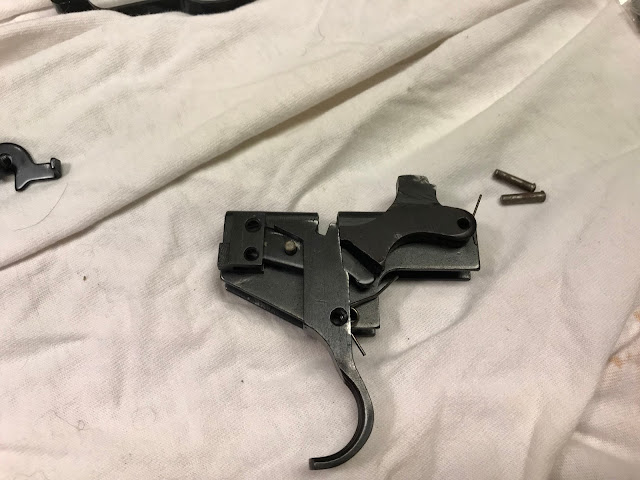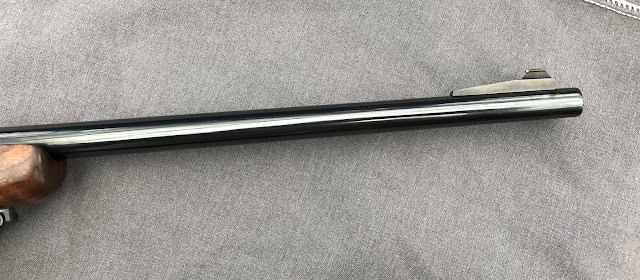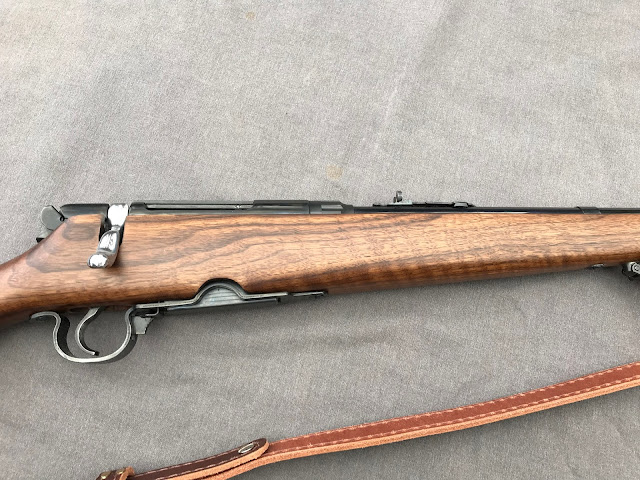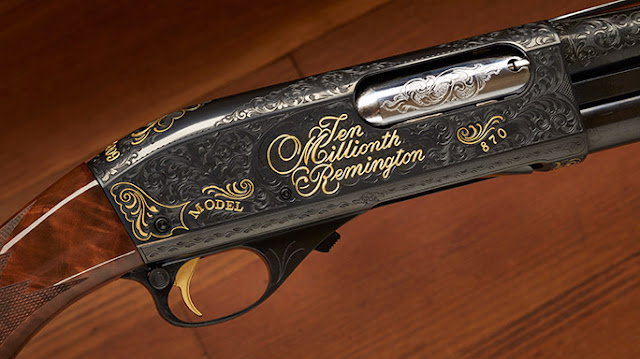A blog dedicated to the love of guns, gun restoration, repair and customization
Friday, September 28, 2018
Tuesday, September 25, 2018
Project Deer Stalker Part 4
If you missed the previous posts on this build, click the links below
Featured Gun
Part 1
Part 2
Part 3
Now that we have the stock finished and the barrel/receiver blued, it is time to re-assemble the rifle
I need to put the trigger assembly back together and attach it to the receiver, in this case we have to do it in reverse order. Attach the trigger housing, then assemble the parts and installing the rivets that hold everything together.
Here is the trial assembly
I had some 5-40 bolts, I used them to fit everything to make sure I had everything in the right place and working.
The pins I ordered did not want to go into the trigger bracket, I didn't really want to try and pound them in while at the same time trying to hold the parts in place. I checked the stock to make sure there would be ample room to install screws, there appeared to be enough space (except for maybe the bottom trigger screw).
So I ordered up some 3/4" long #5-40 screws and locking nuts
The nut and bolt approach did not work out, there was just not quite enough room to make them fit and I didn't want to inlet the stock any further, so back to the rivets. I cleaned up the original rivets, installed them and then peened the back sides with a center punch
I had to do a little bending to get the trigger guard to fit just right, these never fit tight, but this stock is actually for the model 340, which has a much straighter grip profile
I needed to adjust the firing pin protrusion (forward maximum travel)...this is as close as I could get, the next setting had it sticking way too far out which could puncture a primer.
Finished!
Costs for the project:
Original Rifle: $100.00
Transfer fee: $12.50
New Walnut Stock: $123.00 (with shipping)
Sling Swivels: $0 (got in a lot of parts I bought)
Buffalo Hide 1" Sling: $24.99
Total: $260.49
Some before and after comparison pictures
Featured Gun
Part 1
Part 2
Part 3
Now that we have the stock finished and the barrel/receiver blued, it is time to re-assemble the rifle
I need to put the trigger assembly back together and attach it to the receiver, in this case we have to do it in reverse order. Attach the trigger housing, then assemble the parts and installing the rivets that hold everything together.
Here is the trial assembly
I had some 5-40 bolts, I used them to fit everything to make sure I had everything in the right place and working.
The pins I ordered did not want to go into the trigger bracket, I didn't really want to try and pound them in while at the same time trying to hold the parts in place. I checked the stock to make sure there would be ample room to install screws, there appeared to be enough space (except for maybe the bottom trigger screw).
So I ordered up some 3/4" long #5-40 screws and locking nuts
The nut and bolt approach did not work out, there was just not quite enough room to make them fit and I didn't want to inlet the stock any further, so back to the rivets. I cleaned up the original rivets, installed them and then peened the back sides with a center punch
I had to do a little bending to get the trigger guard to fit just right, these never fit tight, but this stock is actually for the model 340, which has a much straighter grip profile
I needed to adjust the firing pin protrusion (forward maximum travel)...this is as close as I could get, the next setting had it sticking way too far out which could puncture a primer.
Finished!
Costs for the project:
Original Rifle: $100.00
Transfer fee: $12.50
New Walnut Stock: $123.00 (with shipping)
Sling Swivels: $0 (got in a lot of parts I bought)
Buffalo Hide 1" Sling: $24.99
Total: $260.49
Some before and after comparison pictures
Saturday, September 22, 2018
Featured Gun: The Remington 870 Wingmaster
What is there to be written about the 870 Wingmaster that hasn't already flowed from the pen of every gun writer since 1950?
I don't have the answer to that question, but I am going to write about it anyway.
Perhaps the best testament to it's design is the fact that the gun, like few others, has remained relatively unchanged for nearly 70 years.
In case you didn't know the 870 Wingmaster is a pump action shotgun made by Remington, the oldest gun maker in America.
Introduced in 1950, the same year the Korean War started, Charlie Brown debuted in comic strips and the telephone answering machine was invented by Bell Labs and Western Electric.
When introduced the standard model (AP) sold for just $69.95.
The design was not remarkable, there had been pump action shotguns since the late 19th century. This was in fact Remington's 4th pump action shotgun design.
Remington's first pump action was the John Peterson designed model 10, which was made from 1908 to 1929 and served in both the World Wars
Remington model 10
The model 10 was unique in that the ejection port also served as the loading port. Being on the bottom of the receiver made the gun ambidextrous, a bonus to left handed shooters.
In 1921 Remington began manufacturing it's second pump action shotgun, the model 17. Designed by John Browning the gun was designated the model 17 due to the year Browning patented the design. The model 17 kept the bottom ejection/loading port of the model 10.
Remington model 17
For those that are unaware, Ithaca copied the model 17, but they had to wait until 1937 for the patents to expire, thus the Ithaca was named the model 37, which is still produced today.
Ithaca model 37
The model 17 was redesigned in 1931 as the model 31 by adding a side ejection port. The model 31 was made from 1931 until 1949 when it was replaced by the 870 Wingmaster.
Remington model 31
a few side notes:
- The model 31 was also made available in a lightweight version with an aluminum receiver, dubbed the 31L.
- The model 31 was not only the basis of design for the 870 Wingmaster but for the Mossberg 500 as well.
- The model 31 is considered to have the smoothest action of any pump action shotgun ever made.
The name "Wingmaster" was chosen as it went along with a series of guns produced by Remington with the "master" moniker:
Targetmaster - Model 41 and later the Model 510, single shot .22 bolt action rifle
Scoremaster - model 511 box magazine .22 bolt action rifle
Sportmaster - model 512, tube magazine .22 bolt action rifle
Matchmaster - model 513 box magazine, .22 bolt action rifle
Fieldmaster - model 572 pump action .22 rifle
Speedmaster - model 552, semi-auto .22 rifle
Woodsmaster - models 740, 742 & 750 semi-auto center fire rifle
Gamemaster - model 141 & later the 760 pump action center fire rifle
Rangemaster - model 37 .22 bolt action (now used on the model 40-XB)
Wingmaster - model 870 pump action shotgun
The 870's receiver is made from a solid chunk of billet steel, most pump shotguns on the market have receivers made from aluminum.
The magazine tubes are made of steel and welded to the receivers, this means adding additional capacity requires a magazine extension, which is available from multiple aftermarket suppliers.
The stocks came in walnut, hardwood, laminate and synthetic depending on the model
Here is a video from 1969 showing how Remington produced the 870 (among other guns) at the Ilion New York plant.
Some Interesting 870 models that have appeared over the years.
In 1972 Remington introduced the "All American" Special Trap Gun. The 870 was covered in scroll engraving, featured finely figured stocks and a vent rib barrel
The 870 P was designed for use by Police (thus the "P" designation). One option was the factory top folding stock
There are plenty of complaints about the design of the folding stock, but they are valuable collectors items today.
In 1992 Remington introduced the 870 with a "Marinecote" finish, the gun was made of standard carbon steel, then given an electroless nickel plating for corrosion resistance. They are now called "Special Purpose Marine Magnum"
In the year 2000, the 870 celebrated it's 50th Birthday and Remington issued a special anniversary edition
In 2016 Remington introduced a 200th anniversary model, The guns came with checkered walnut stocks, factory engraving and gold inlays. Only 2016 of them were built.
They also created some special Bicentennial editions which were auctioned off
In late April 2017, following the introduction of the Mossberg Shockwave, Remington introduced the Tac-14 model. The Tac-14 features a special hand grip and a 14" barrel. Normally a 14" barrel would be regulated under the 1934 NFA as a "Short Barrelled Shotgun", but......this one isn't. The law defines a shotgun as having to be fired from the shoulder. The Tac-14 comes from the factory without a shoulder stock and is not designed to be fired from the shoulder, thus it is just a firearm. Why not a 12" or 10" barrel you ask, well as a firearm (not a pistol) it must have an overall length of at least 26", and with the minimal hand grip, 14" is about as short as they could go and still be within the bounds of the law. Keep in mind Short Barrelled Shotguns are totally legal and unregulated in Canada.
The TAC-14
In 2018 Remington introduced the 870DM model (DM for detachable magazine). The magazine which fits into a special adapter mounted over the loading port. This is not simply a conversion kit, but a whole new model with modifications specific to the feeding from detachable box magazine. The magazines are proprietary and the model will come in five different configurations
the 870DM
Once the patents on the 870 expired, copies began showing up. The most popular is the Norinco made IAC 98/980 series "Hawk"
Then there was the S&W 3000, made by Howa in Japan it was a near exact copy of the 870 except with an aluminum receiver. S&W imported these for a while, before giving up on the shotgun market
Providing specs for the 870 might seem a bit useless as the gun came in so many different configurations, but here are the specs for my 1955 vintage Wingmaster
Specs:
Caliber/Gauge: 12 Gauge (also made in .410, 28, 20 & 16)
Weight: 8.0 lbs (varies from 7.0 to 8.0 lbs)
Length: 44" (can vary from 26" to 50.5")
Barrel length: 26" (can vary from 14" to 30")
Magazine Capacity: 4+1
Finish Metal: polished blued (also available in matte blued & nickel plated)
Finish Stocks: Walnut (also available in hardwood, laminate or synthetic)
The 870 exceeded the sales expectations of the Remington Executives. By 1966 (16 years into production) they had sold 1 million 870 Wingmasters. Two million by 1973, which was ten times the number of model 31, which the 870 replaced.
With the help of LEO contracts, sales began to accelerate as it only took another 4 years to sell the 3 millionth 870 in 1978. Another six years to reach 4 million in 1984 and six more in 1990 to get to the five million milestone.
On Monday April 13th, 2009, the ten millionth 870 shotgun was produced. The gun was culled from the herd and sent off to the custom shop for special embellishments.
The 870 in all its forms is the most prolific shotgun ever made. To date close to 12 million 870s have left Remington's Ilion, New York facility. It really was a wonder to me why I didn't own one (or three...).
I had for a long time wanted to own a Remington Wingmaster. I missed out on an opportunity to buy a '70's/'80's vintage Police issue Wingmaster in a group buy and since then have been on the look out for a good deal on one
I bought my first Remington 870 Wingmaster for $150, it was at a local gun store who was having a "garage sale" clearing out some old inventory.
It appeared to be an older model, so I went searching for info on the date of manufacture.
in 1968 Remington added a letter prefix to the serial number. This gun has no prefix, meaning that it was built before 1968. The barrel date code is "B B" which means that unless the barrel was changed (it matches the gun in both age and the machining) it was made in 1933 or 1955, the 870 was introduced in 1950, therefor this gun was made in 1955, which makes it a classic!
I think I will probably leave it as is. The finish is about 75-80% intact and the wood is in decent shape.
This second Wingmaster came to me just a couple of months after getting the first one. This one is newer, but in much worse shape, nothing that cannot be remedied though.
The prefix on the serial number dates the gun to 1968-1974 and the date code on the barrel (assuming it is the original barrel) dates the barrel to 1974, so I can be pretty sure it was made in 1974.
Stay tuned for posts on this project
We'll finish this post with some 870 gun porn
Sources
Ammoland
Range 365
Gun Digest
Subscribe to:
Posts (Atom)






















































































